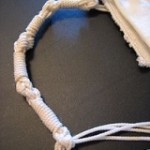Thread of blue – Ask the Rabbi
Q. Why don’t we have a thread of blue among the fringes of the tallit, as required by the 3rd paragraph of the Shema?
 A. The thread of blue commanded in Parashat Sh’lach (Num. 15:38) had to be t’chelet.
A. The thread of blue commanded in Parashat Sh’lach (Num. 15:38) had to be t’chelet.
Its purpose, according to the rabbis, is that blue suggests the sea, the sea suggests the heavens, and the heavens suggest the Throne of Glory. Thus the tzitziyyot with the blue thread are a reminder of our duty to God.
In other ancient cultures the wearing of blue or purple was also highly esteemed as a mark of royalty (“royal blue”) or nobility.
The t’chelet dye derived from a snail called a chillazon, a small marine creature with a hard shell which was found along Israel’s northern coast.
The dyeing process came to an end in the 7th century CE when the secret of the chillazon was lost. The Midrash then declared, “Now we have only white (fringes), for the t’chelet is not found” (Num. R. 17:5).
It appears that with the Arab conquest the Palestinian dyeing industry came to an end, though here and there traces of it remained.
In the 19th century the Radzyner Rebbe (R. Gershon Henoch Leiner) found a squid which he was convinced could produce the right kind of blue dye. With the aid of Italian scientists he succeeded in obtaining the blue colour. He and his followers put a thread of blue in their tzitzit, but his initiative was widely criticised.
Rabbi Isaac HaLevi Herzog, later chief rabbi of Israel, in his doctoral work, analysed the process used by the Radzyner Rebbe and concluded that the mures trunculus was a likely source of t’chelet.
True, the chillazon, according to the Talmud, has a body that resembles the sea, whereas when the murex trunculus is out of the water it is off-white with brown stripes. However, when it is still in the sea it does look like the sea bed.
An Israeli group has now begun producing tzitzit with the thread of blue. Dr Baruch Sterman of Efrat in Israel has documented the story in his book, “Techelet: the Renaissance of a Mitzva“, published by Yeshiva University Press.
The law of t’chelet has its ethical side. Though Korach needled Moses with his question, “Does a garment which is kullo t’chelet – totally blue – require a blue thread?”, rabbinic thinking described a person who is ethically consistent both on the surface and within, as kullo t’chelet.
Zionism of course adopted the blue and white of the tzitzit as the Israeli national colours and for the flag of the State.



